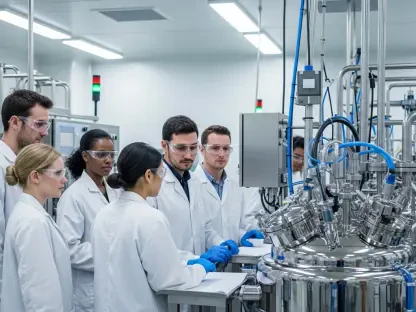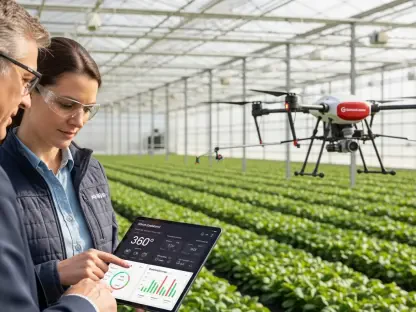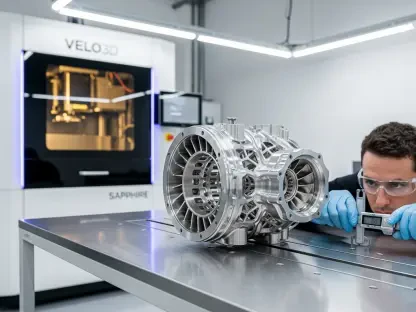The dawn of industrial artificial intelligence marks a pivotal shift in asset-heavy industries, forecasting profound advancements and unprecedented efficiency gains. Industrial AI, a convergence of cutting-edge technologies, is reshaping sectors such as manufacturing, energy, and transportation, promising a market poised for exponential growth by 2030. As industries navigate the intricacies of integrating AI into their operations, the push towards automation, smart analytics, and sustainable energy solutions accelerates. The landscape is characterized by diverse applications, each underpinned by transformative technologies like Generative AI, Edge AI, and AI-driven robotics. These innovations are collectively enhancing productivity, optimizing resource allocation, and enabling strategic decision-making across the board.
Market Overview and Emerging Trends
Economic Implications and Growth Projections
Industrial AI is anticipated to experience a period of sustained double-digit growth, making it a multi-billion-dollar market by year’s end. As global economies pivot towards digitization, this trajectory signals significant economic implications for industries that adopt AI strategies. The burgeoning market size reflects the escalating demand for AI-driven solutions that address specific industry needs, ranging from supply chain optimization in manufacturing to predictive maintenance in energy sectors. The competitive landscape reveals active participation from major players and new entrants, each vying to carve out a piece of this burgeoning market through innovation and strategic collaborations. Key trends driving this growth include the integration of AI into existing workflows, investments in R&D, and the digital transformation initiatives undertaken by traditional industries aiming for operational efficacy and cost-effectiveness.
Technological Advancements and Innovations
Technological innovations play a crucial role in shaping the future of industrial AI, with pivotal developments in AI-related technologies significantly enhancing their utility in industrial settings. Generative AI and Edge AI, alongside advances in robotics, are central to this evolution. Generative AI is transforming design and prototyping processes, enabling quicker iterations and innovative solutions in product development. Meanwhile, Edge AI facilitates real-time data processing, reducing latency and ensuring faster decision cycles in critical applications. Robotics, infused with AI capabilities, boosts automation levels, particularly in repetitive or hazardous tasks, thereby enhancing overall safety and precision in manufacturing processes. Rapid advancements in these technologies are fostering a collaborative ecosystem, where the synergies of different AI applications enhance their collective impact, leading to smarter, interconnected industrial environments.
Challenges and Strategic Approaches
Adopting AI in Asset-Heavy Industries
The integration of AI into asset-heavy industries is not without its challenges, with significant barriers impeding seamless adoption and deployment. Technical issues, such as data interoperability, lack of standardized protocols, and concerns around cybersecurity, present formidable obstacles. The complexity and high cost of AI technologies can act as deterrents for industries hesitant to undertake significant investment without clear ROI. Cultural resistance within organizations and a shortage of skilled AI professionals further complicate adoption, necessitating strategic initiatives to overcome these hurdles. Addressing these challenges requires a multi-faceted approach, including fostering a culture of innovation, investing in skill development, and leveraging partnerships with AI specialists. Such strategies enable organizations to build robust AI frameworks, facilitating smoother transitions and adaptations.
Examining AI Use Cases and Success Stories
Real-world use cases underscore the transformative power of industrial AI, offering valuable insights into its potential applications and benefits. For instance, AI-driven predictive analytics in energy sectors helps preempt equipment failures, significantly reducing downtime and maintenance costs. In manufacturing, AI optimizes production lines, improving both speed and quality through advanced machine learning algorithms that tailor operations based on real-time data analysis. Case studies from industry leaders showcase effective AI adoption strategies, highlighting tailored solutions that align with organizational goals and resource capacities. These success stories not only illustrate the possibilities but also provide templates for other enterprises to emulate, emphasizing practical benefits such as increased operational efficiency, reduced environmental impact, and enhanced competitiveness in global markets.
Strategic Pathways into the Future
The acceleration of industrial AI adoption suggests that organizations must strategically position themselves to harness its full potential. Investing in innovation-focused research, forming strategic alliances, and advocating for industry standards form the backbone of a proactive approach. Industries will need to prioritize data-driven methodologies, ensuring that their infrastructure can support sophisticated AI applications across diverse operations. It is essential to cultivate workforce competencies through targeted training programs, bridging skill gaps and securing a talent pool adept in leveraging AI technologies. Moreover, a strong emphasis on cybersecurity and ethical AI practices would safeguard against potential risks, fortifying the trust and reliability of AI systems. Such strategic pathways are instrumental in driving sustainable growth, maximizing productivity, and fostering an ecosystem conducive to continuous technological evolution.









